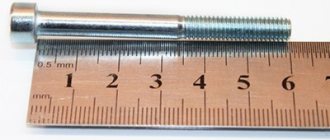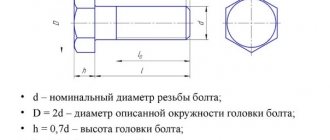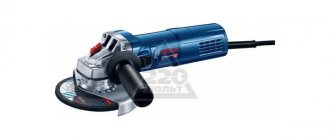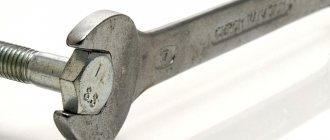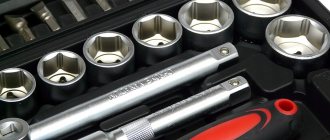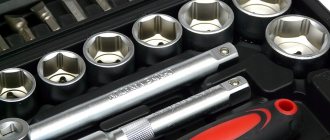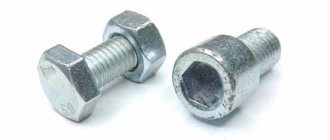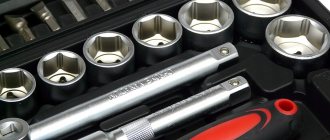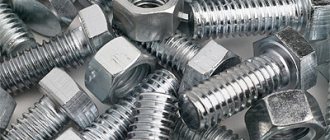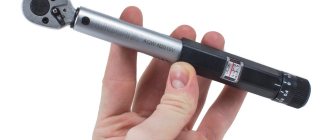There are often situations in life when you need to unscrew or tighten bolts and nuts. Most often, an ordinary wrench is used for this: from the simplest (with different horns on both sides) to more expensive models (allows you to choose the required size yourself). And if experienced specialists can determine the size of a nut by its appearance, then an ordinary person will most likely have to make do with brute force.
In this article we will tell you how to correctly determine the size of a nut or bolt, provide a table with standard sizes for convenience, and also share some tips.
Wrench: what do you need to know when choosing?
A wrench is a tool designed for screwing and unscrewing fasteners (usually nuts or bolts). We have already stated above that keys come in different types. For example, by design they are divided into:
- carob;
- caps;
- end;
- combined;
- adjustable;
- clamping;
- tubular;
- drums;
- split;
- with ratchet.
The most popular type is the open-end wrench. The requirements for its technical characteristics are set out in detail in GOST 2839-80, but we are only interested in the size of the pharynx (the cavities between the jaws that resemble horns). Markings are usually found on each side of the key body.
Stud sizing technology
Studs, like other hardware, are distinguished by the presence of metric threads, therefore they have the corresponding abbreviation MDxPxL. The decoding is also no different from the previous fasteners:
The type of measurement is selected in accordance with the appropriate GOST standard, as well as the type of stud. In total, there are 2 large groups for determining the ownership of hardware:
In the first case, the working part is presented along the entire length of the hardware; in the second case, only the shank is used, while the end for twisting is not taken into account.
Hairpins, like other hardware, are produced according to the following standards:
There are also other options that differ in the twisted end and length. For them, other GOST standards apply.
How to choose the right wrench for the size of the bolt and nut?
There are two designation systems: in millimeters (metric according to GOST) or in inches (standard for Europe and the USA, where 1 inch equals 2.54 cm). Therefore, it is important to determine which standard we are working with, and then select the size.
Wrench Size Chart for Metric Thread Nuts and Bolts
From this table you can easily determine what size wrench is required for fasteners with metric threads, from M1 to M110.
| Thread diameter, M | Key size | ||
| Main S, mm | Reduced S, mm | Increased S, mm | |
| M1 | 3.2 | — | — |
| M1.2 | 3.2 | — | — |
| M1.4 | 3.2 | — | — |
| M1.6 | 3.2 | — | — |
| M2 | 4 | — | — |
| M2.5 | 5 | — | — |
| M3 | 5.5 | — | — |
| M4 | 7 | — | — |
| M5 | 8 | — | — |
| M6 | 10 | — | — |
| M7 | 11 | — | — |
| M8 | 13 | 12 | — |
| M10 | 17 (16) | 14 | — |
| M12 | 19 (18) | 17 | 21 (22) |
| M14 | 22 (21) | 19 | 24 |
| M16 | 24 | 22 | 27 |
| M18 | 27 | 24 | 30 |
| M20 | 30 | 27 | 32 (34) |
| M22 | 32 (34) | 30 | 36 |
| M24 | 36 | 32 | 41 |
| M27 | 41 | 36 | 46 |
| M30 | 46 | 41 | 50 |
| M33 | 50 | — | 55 |
| M36 | 55 | 50 | 60 |
| M39 | 60 | 55 | 65 |
| M42 | 65 | 60 | 70 |
| M48 | 75 | — | 75 |
| M52 | 80 | — | 80 |
| M56 | 85 | — | — |
| M60 | 90 | — | — |
| M64 | 95 | — | — |
| M68 | 100 | — | — |
| M72 | 105 | — | — |
| M76 | 110 | — | — |
| M80 | 115 | — | — |
| M85 | 120 | — | — |
| M90 | 130 | — | — |
| M95 | 135 | — | — |
| M100 | 145 | — | — |
| M105 | 150 | — | — |
| M110 | 155 | — | — |
The sizes of modern ISO standards are indicated in brackets. For household ones, it is enough to use the numbers in the second column.
Size chart for inch wrenches for nuts and bolts
Inch hardware differs in size from the metric standard by literally fractions of millimeters. Therefore, metric wrenches do not fit tightly onto the edges of inch fasteners, and sometimes do not fit at all.
| Thread diameter (key size), inch | Nut size, inch | Nut size, mm |
| 1/4 | 7/16 | 11.11 |
| 5/16 | 1/2 | 12.7 |
| 3/8 | 9/16 | 14.29 |
| 7/16 | 5/8 | 15.88 |
| 1/2 | 3/4 | 19.05 |
| 9/16 | 13/16 | 20.63 |
| 5/8 | 15/16 | 23.81 |
| 3/4 | 1 1/8 | 28.58 |
| 7/8 | 1 5/16 | 33.34 |
| 1 | 1 1/2 | 38.10 |
| 1 1/8 | 1 11/16 | 42.86 |
| 1 1/4 | 1 7/8 | 47.63 |
| 1 3/8 | 2 1/16 | 52.39 |
| 1 1/2 | 2 1/4 | 53.15 |
| 1 3/4 | 2 5/8 | 66.68 |
| 2 | 3 | 76.20 |
| 2 1/4 | 3 3/8 | 85.73 |
| 2 1/2 | 3 3/4 | 95.25 |
| 2 3/4 | 4 1/8 | 104.76 |
| 3 | 4 1/2 | 114.30 |
Hex bolts and nuts
When assembling and repairing machines, bolts with a cylindrical head are widely used, which require a special hex key to work with. Such bolts are manufactured according to DIN 912 (Europe) or GOST 11738-84 (Russia) standards. For us, only one parameter is important: the distance between the opposite faces of the internal hexagon.
| Thread, M | Key size, mm |
| M4 | 3 |
| M5 | 4 |
| M6 | 5 |
| M10 | 8 |
| M12 | 10 |
| M14 | 12 |
| M16 | 14 |
| M18 | 14 |
| M20 | 17 |
| M22 | 17 |
| M24 | 19 |
| M27 | 19 |
| M30 | 22 |
| M33 | 24 |
| M36 | 27 |
How to find out the size of a rivet
Solid rivets equipped with a closing head and installed with a hammer are presented in the documents as the abbreviation DxL. The decoding is as follows:
Depending on the GOST standards used and the design of the solid rivet, there may be a difference between the methods for determining the length of the hardware, therefore there are 3 separate groups by type:
During production, different GOST standards are used:
There are also tear-off rivets, the installation of which is carried out using a gun. In this case, hardware is also designated as the previous ones.
If we consider production standards, we can highlight the following:
Adjustable wrench. Sizes by numbers
Category: Tool | Published: 8-12-2017, 18:50
Every self-respecting master in his collection of tools, in addition to several dozen ordinary wrenches, has an adjustable wrench.
There are situations when you don’t have a suitable size wrench at hand or you need to unscrew a non-standard connection; it is at this moment that our universal adjustable wrench comes to our aid.
Today, we will find out what sizes and numbers of adjustable wrenches there are, touch on the history of creation and talk a little about the right choice.
Design features and history of creation
By and large, an adjustable wrench is the same wrench, only with a small modification in the form of a worm gear that moves the lower jaw of this tool.
A thought probably flashed through your head, so why doesn’t this device replace open-end wrenches? The fact is that its versatility has one huge disadvantage. The existing play between the jaws of the adjustable wrench greatly limits the torque.
In simple terms, it is easier to unscrew or tighten the connection more tightly only with an open-end wrench, that is, where the jaws are motionless. As for the alloys from which the tool is made, high-carbon steel with the addition of chromium and vanadium is most often used.
Also, to improve the quality of the metal, the key can be nickel-plated, chrome-plated or phosphated.
If we talk about the history of the creation of the key, then three nations claim the palm: the British, the French and the Swedes. Of course, these disputes will be endless, just as people’s desire for fame is endless. But let's look at each candidate separately, and make your own verdict.
The British nominate two engineers for the post of inventors of the adjustable wrench: Richard Cliburn and Edwin Budding. The latter, by the way, invented the lawn mower.
The first version of the key was a massive and formidable tool, the lower jaw of which moved with the help of a threaded bolt located on the handle.
It was not very convenient to work with it in hard-to-reach places, and due to its massiveness, it was often used as a hammer.
As for the French, they are convinced that their compatriot Monsieur Le Roy-Tribault was the creator of the first sliding key. The patent was recorded in 1837, which predates the British by six years. The British first presented and registered their invention in 1843. Yes, by the way, this is what the first sliding key looked like.
But most experts claim that the father of the adjustable wrench is the Swedish mechanic Johan Petter Johansson. The owner of his own workshop for the maintenance and repair of agricultural machinery, when going to each call, he had to take more than a dozen wrenches.
As a result, he gets tired of this state of affairs and upgrades the wrench to an adjustable wrench. He himself called his invention an “iron hand.” Later he will finalize his invention and the gas wrench will see the light of day, probably the most necessary tool for a professional plumber.
It was not until 1891 that the Stockholm company Bacho began large-scale production of these useful tools.
Sizes by numbers
- KR-19
. The marking means that the lower jaw can only be opened by 19 mm, this will be the maximum size of the bolt to be unscrewed. This key is small in size and very convenient to use. - KR-30
. Medium size adjustable wrench. The adjustment range of the lower jaw is from 0 to 30 mm. It is the golden mean, copes with most household duties, and is often used in plumbing work. - KR-46
. The working range of the tool is from 0 to 46 mm. A key with this number belongs to a special type and, most likely, you will not see it in a home craftsman’s kit. It is mainly used in production for servicing machines and mechanisms.
When working, you need to take into account that adjustable wrenches have an allowance of 2-3 mm, and the jaws of the adjustable wrench can grab another couple of millimeters. For example, with a KR-30 key, you can freely unscrew the thirty-second bolt.
Tips for choosing
The main and main indicator at all times has been cost, and an adjustable wrench is no exception. A good key KR-19 will cost you 400 rubles, KR-30 costs about 700 rubles, and KR-46 approximately 1500 rubles, and these are average prices, excluding professional tools.
Today the following are considered good manufacturers: Matrix, Stanley and Truper; among domestic ones I would like to note: Intertool and Mastertool. Remember that when choosing, you should give preference to sets of adjustable wrenches so that you are prepared for any situation.
When working, it is very important that the tool fits well in the hand and does not slip out; for this purpose, the handle is covered with a layer of PVC or rubber, and if you work with electricians, then you can find dielectric adjustable wrenches on sale that can protect you from electric shock. Their price is, of course, higher, but safety should come first.
When it comes to durability, always choose adjustable wrenches made from high-carbon steel with chrome and vanadium alloys in the composition. Regarding spraying, we can say that it does not play a big role in the strength of the tool.
Tags for this article: Keys
Source: https://siblizcom.ru/instrument/985-razvodnoy-klyuch-razmery-po-nomeram.html
Mass types of keys
Touching on the topic of wrenches, an unforgettable image of an open-end wrench appears before your eyes. The nuts are fixed using lips that look like horns. This is where the name comes from. The second name for such means is used by GOST - open-jaw wrench. The center lines of the handle and head most often intersect at an angle of 15-20 degrees. When manipulating in tight spaces, this configuration will make the work easier. The angles between the axes of the head and handle are made in different sizes; opposite heads have different slopes from each other. Horn models are typically divided into various modifications:
- Double-sided instruments have two jaws of different dimensions. Usually their size designations are adjacent (18−19 mm). The jaws can have different thicknesses: thin ones work in hard-to-reach places, while thick ones are used for loosening nuts made of soft materials.
- For one-sided ones, the body is lengthened in order to increase the moment of force when interacting with fasteners. It is used in assembly production for operations with the same type of nuts. Some models have a locking shank for tube extensions.
- High-speed with a modernized working profile and a shortened jaw for high-speed movement of the key from one element to another. The rotation changes when the tool is turned one hundred and eighty degrees.
- Profile cuts on the lips of open-end wrenches increase the number of contact points and shift the location of the boundaries of the fastening components relative to the jaw. The turning force does not damage the structure in the planes of the nut or in the heads of the bolts, and allows you to unscrew deformed elements.
- A wrench with a working profile in the form of a ring, which is put on the mounting surface, is called a spanner. They can have rings at both ends of the working plane. There are edges along the inner diameter. There are six or twelve of them. The hex power tool unscrews tight, soured connections easily and without damage. Twelve-sided is used when working space is limited. The working profile can be made elongated for the use of attachments. The undoubted advantage of the attachment tool is the permissibility of exerting a large force on the unscrewing planes and working in cramped areas. The weak point is discomfort when working with threads of increased length.
- Devices that have a horn-type head on one end and a cap or end-type head on the other are classified as combined. Their heads are the same size on both sides. The dimensions of the body length are different: when space is limited - shortened standard increasing forces - elongated ones creating the maximum peak of pressure - extra long.
- A tool with a variable working profile is called an adjustable tool. The transformation occurs due to a screw mechanism or slider, which moves the moving part to the required width. The clamping of the fixing parts is not tight, which leads to the rolling of the edges. A plus is the possibility of using it with nuts of various diameters.
